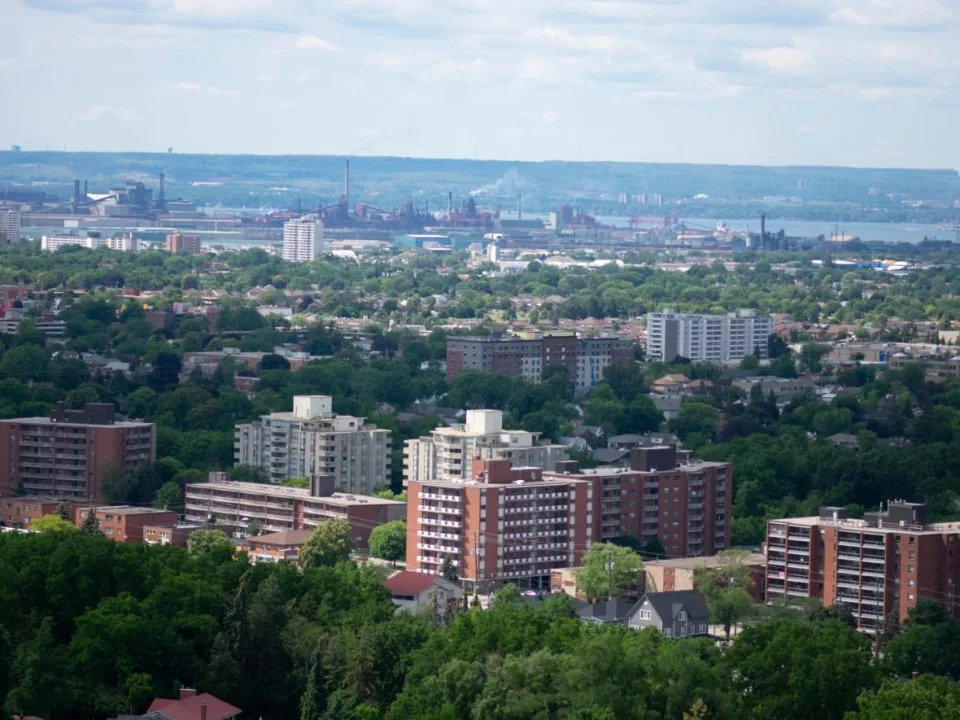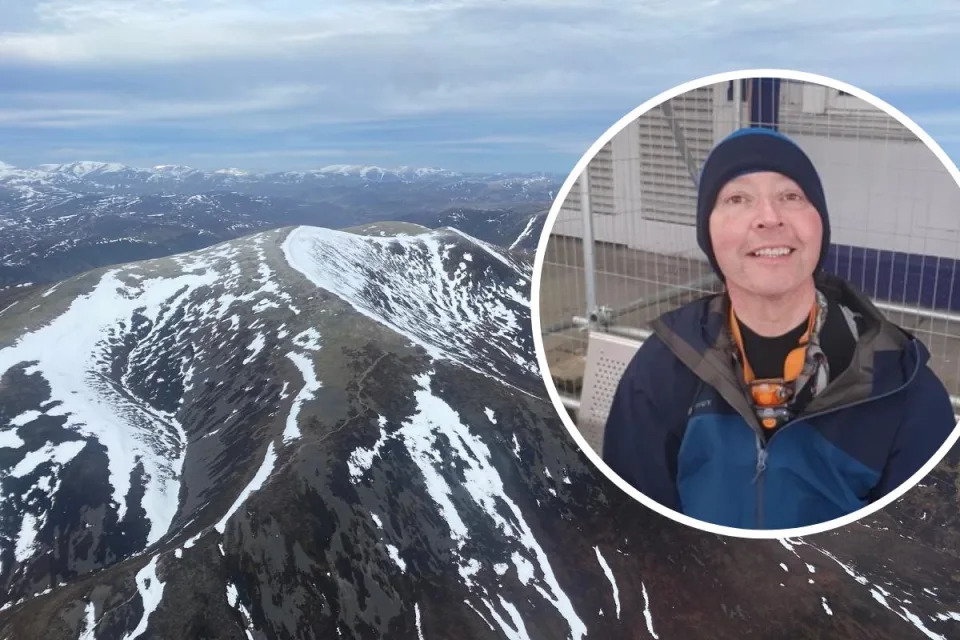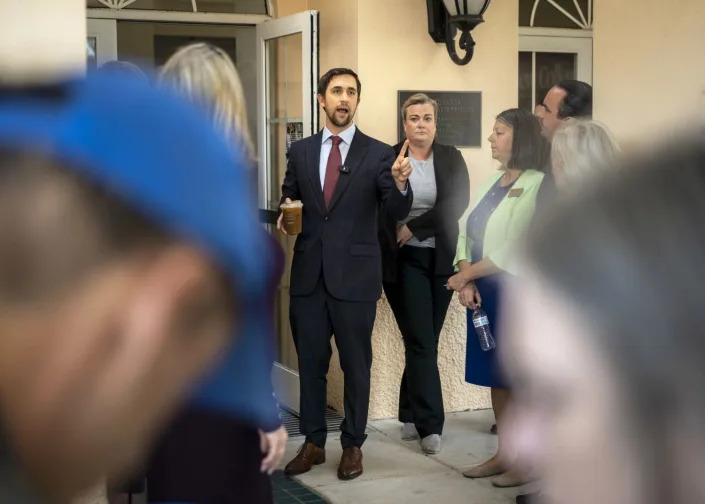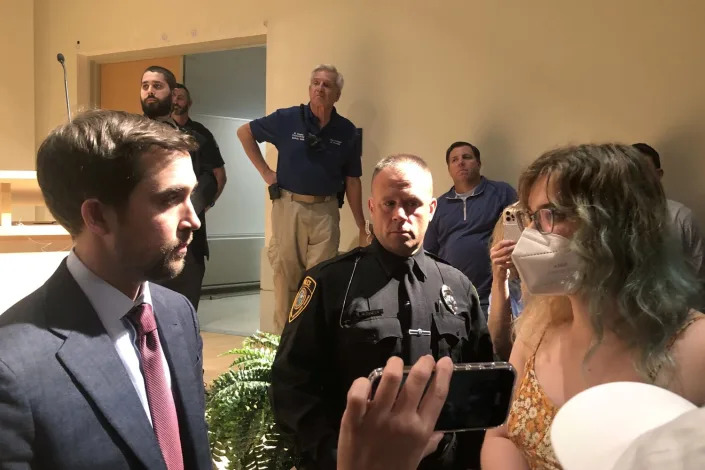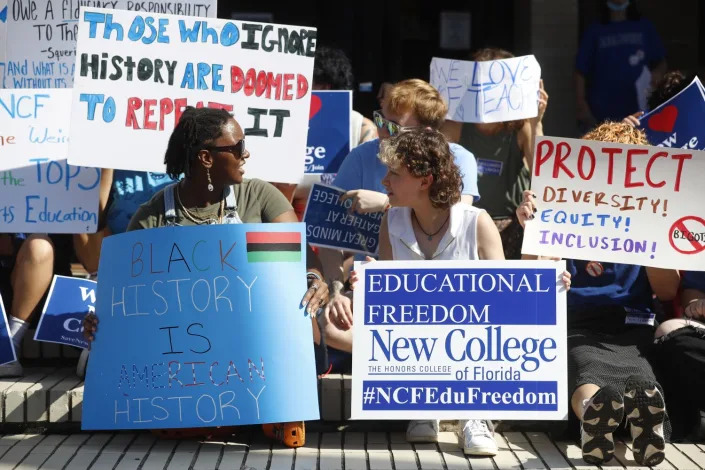How much money is your state spending to defend against climate change? What we learned
LONG READ
Kim Strong and Gareth McGrath
Sun, February 5, 2023
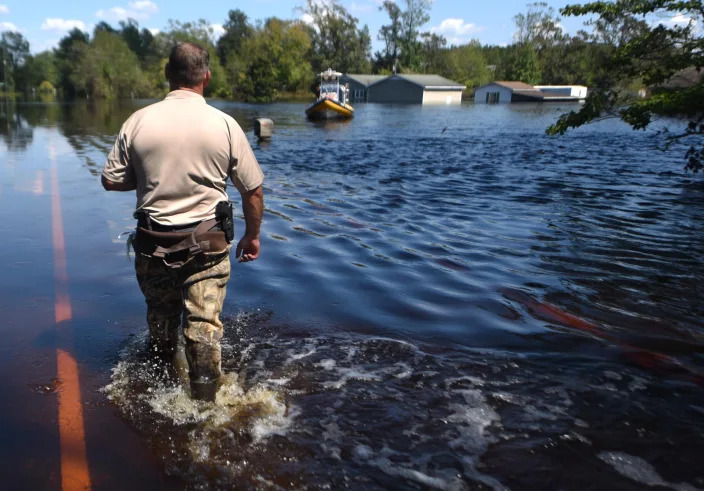
Lt. Keith Ramsey with the Pender County Sheriff's Office helps rescue efforts in Burgaw, North Carolina, in September 2018 after floodwaters from Hurricane Florence swamped much of eastern North Carolina.
North Carolina became the object of some national scorn when it ordered coastal regulators a decade ago to ignore the latest scientific predictions of how fast the seas would rise in the coming decades.
Proponents of the short-lived 2012 state law said embracing worrisome projections on sea-level rise, which they claimed were based on unproven scientific research techniques, would prompt costlier home insurance and anti-development alarmism along the tourism-dependent coast.
Critics, including comedian Stephen Colbert, accused state officials of "outlawing the climate models" and blinding themselves to the effects of climate change.
Then two record-setting flooding events, Hurricanes Matthew in 2016 and Florence in 2018, devastated many of the same parts of Eastern North Carolina.
Today, North Carolina is one of 13 states and 34 cities that have added a chief resilience officer and, in most cases, an office of recovery and resiliency, according to the Institute for Sustainable Development.
Dr. Laura Hogshead, director of the N.C. Office of Recovery and Resiliency, said the drumbeat of natural disasters occurring in quick succession helped sway Tar Heel State political and public opinion that it can't be business as usual anymore, with rebuilding as the plan.
"It’s not a political lightning rod anymore because there's a recognition that flooding, for example, is getting worse, more frequent," she said. "We might not always agree on how it's happening, but we do agree that we have to prepare better for it."
However, not all cities or even states along the East Coast have an organized, public plan to protect citizens from the climate crisis as best they can with existing tax dollars — or with increased taxes — and with ingenuity and collaboration.
Our "Perilous Course" project team of USA TODAY Network journalists pressed governments this summer on:
what coordinated public climate crisis action plans they have approved
what they have published to citizens and conducted open forums about
what they have put new money toward as the depth of the climate crisis has become more clear
Not all the governments we asked would answer. Not all could answer: Some had no coordinated action to report.
Meanwhile, scientific and economic forecasts for climate crisis damage and costly change and citizen danger have only grown. For instance, this summer, spots across the East Coast dealt with extreme heat that opened eyes to the vulnerabilities baked into the way our cities are built and where they are built.
'We need to adapt'
As effects of climate crisis creep into the daily lives of more people, some state and local governments are scrambling to adapt and plan ahead.
But while the science leads, progress on public and political pressure to change moves in fits and starts. Decisions to spend public money on climate crisis actions to help citizens, in many cases involving solutions politically unpopular in some circles, are often lagging or disjointed.
"A lot of people don't want big government or more government in their lives, and don't want to pay more taxes for programs or projects they don't understand or think are necessary," said Dr. Ashley Ward, a climate health scientist at Duke University. "I understand the push and pull here.
"But we need to adapt."
Is your state ready?
Most states along the East Coast do not have a unified plan or budget for combatting climate change. That’s according to documents garnered through our Freedom of Information Act requests, sent to state agencies and some key city governments in June, July and August by USA TODAY Network reporters.
Most governments we reached denied the requests because they were unable to provide a budget or documents specifically tied to funds spent on the climate crisis, citing the lack of a dedicated budget for dealing with the extent of the erosion of quality of life coming from global warming.
A Delaware FOIA officer estimated that 120 working hours would be necessary to gather the numbers, at a quoted cost of over $4,500 to our newsroom or any citizen requestor.
“There’s not a line item in the budget for climate change,” said Neil Shader, press secretary for Pennsylvania’s Department of Environmental Protection. “But the investments are happening all over.”
However, the Pennsylvania budget does have specific, dedicated line items for agriculture, education and health, among other priorities.
Michael Healey, spokesman for the Rhode Island Department of Environmental Management, said the same thing, but with more letters.“You’re probably talking about the whole alphabet soup. Along with DEM, there’s OER, RIDOT, DOA, CRMC, RIDOH, Commerce, RIEMA, the Statewide Division of Planning, RIIB, DPUC, RIPTA, and likely URI, RIC, and CCRI, and I may be missing some," Healey said in an email. "On top of that is the fact that cities and towns also are spending a lot of their own money on these issues.
"We agree that this would be a very helpful number to know.”
Florida was asked to provide specifics but did not, sending a vague statement weeks after the request: "Since 2019, more than $1.1 billion has been directed solely to fortifying resilience infrastructure and building on the success of the prior three years’ investments, the fiscal year 2022-23 budget continues this momentum with more than $500 million dedicated to increasing the resilience of Florida’s communities."
That came from Alexandra Kuchta, Florida's Department of Environmental Protection press secretary, who promised to provide a breakdown of those numbers but did not.
Many officials were quick to point out that progress is being made, often by reaching across the political aisle.
Last year, Republican Massachusetts Gov. Charlie Baker signed climate legislation legally binding the state to cutting emissions in half by 2030 and reaching net zero by 2050. In North Carolina, Democratic Gov. Roy Cooper and Republican leaders from the General Assembly hammered out a deal that mandates a 70% reduction in carbon emissions from 2005 levels by 2030 and to reach carbon neutrality by 2050. In Pennsylvania, Democratic Gov. Tom Wolf signed a contract to move toward a goal of 50% of the government’s electrical needs being met through renewable solar energy.
In 2019, New York enacted its sweeping Climate Leadership and Community Protection Act, which set out goals to reduce emissions by at least 85% by 2050. The state says investments avert billions of dollars in losses to the state from the effects of climate change, including with increasingly worse flooding during storms and sea-level rise. Meanwhile, state officials say action could result in billions in benefits with new jobs added in the state.
Steps along the way include a turn to renewables and setting equity goals for those most affected by the effects of climate change. In November, a part of New York Gov. Kathy Hochul’s climate agenda will face voters with a $4.2 billion bond measure that would go toward reducing flood risk and other climate change mitigation efforts, as well as water quality improvement and resilient infrastructure.
Other states, besieged by flooding, have funneled money toward climate mitigation efforts.
In Florida, the Agriculture and Consumer Services Department received $2 million for climate adaptation and mitigation efforts in its previous fiscal budget, the first time such funds had been requested, moving toward a five-year, $10 million program. South Carolina launched a resilience and recovery program in response to repeated flood and hurricane disasters in 2015, 2016 and 2018 and has about $350,000 committed now to a risk reduction and resilience plan.
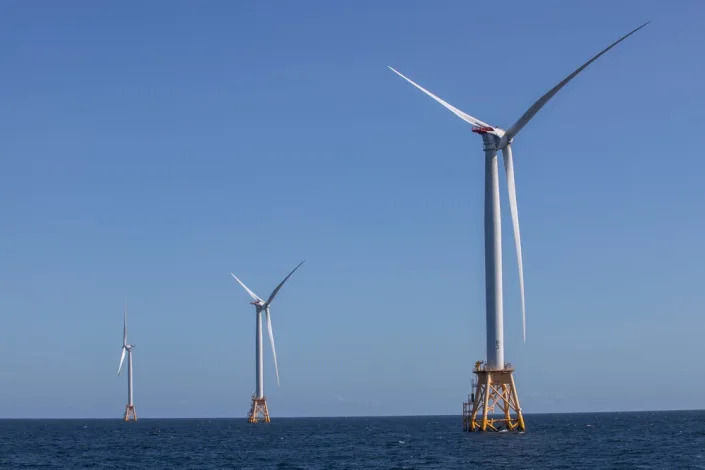
States along the Eastern Seaboard are betting big on offshore wind farms to help them reduce their carbon footprints and make their energy grids more u0022green.u0022
The five wind turbines standing in the waters off Block Island are the clearest example of Rhode Island’s efforts to address climate change. Completed in 2016 at a cost of about $300 million, the nation’s first offshore wind farm wouldn’t have gone ahead without strong support from a succession of Rhode Island governors and extremely favorable state legislation.
In Delaware, John Carney’s administration unveiled in November a plan to reduce emissions and stall effects of climate change, but its greenhouse gas reduction commitments fall short of targets adopted by most Mid-Atlantic states. New Jersey and Pennsylvania each set 80% cuts to be met by 2050. Maryland has adopted a goal of by 2031 reducing emissions by 60% from 2006 levels. Delaware’s plan sets out for a 26%-28% emissions reduction by 2025.
The cost of what isn't being done, of inaction, could cost states billions.
It also promises to affect the most vulnerable citizens most of all.
Some officials claim that these small investments that are being made could yield benefits toward new jobs in renewable energy sectors, while also ensuring communities most affected by climate change aren’t left out.
“Our climate investments are creating a thriving renewable energy sector fostering tens of thousands of family-sustaining jobs and working to ensure climate justice across the State,” said Haley Viccaro, a spokesperson for the New York State Department of Environmental Conservation, in a statement.
On the local front, you might find some of the more visionary ideas.
Warren, Rhode Island, a small town surrounded by water, is working on a “managed retreat” plan in response to rising seas that is the first of its kind in that state.
The town is contemplating buying out property owners in one waterlogged neighborhood and carving out a new housing and business district on higher ground not far away. The plan would be phased in over time with an ultimate goal of buying 306 properties for a total cost of $138 million and tearing them down to allow the area to revert to wetlands.

In Warren, with large tracts of land only two feet above sea level the ocean creeps into backyards, basements and across property lines
Progress being made, but still lots of 'looking in the rearview mirror'
Anna Weber, a policy analyst at the Natural Resources Defense Council, said the uneven response of state and local governments to the climate crisis doesn’t mean progress is non-existent.
There are efforts to address the easier steps, like reducing carbon emissions from tailpipes and smokestacks. But she said it’s going to take leadership and “climate-smart decision making,” which often isn’t popular, to push home change that is real and visible.
Laura Lightbody, who directs The Pew Charitable Trusts’ flood-prepared communities initiative, echoed the sentiment.
With no national vision or guidance on how the U.S. should be adapting for the future, she said, states and local communities have been largely left on their own to navigate their response to climate change.
“So, it’s a little too early for us to know and to be able to really determine what the right way to do it is,” Lightbody said. “But there is a change, a shift that’s started to happen.”
Still, even the best-intentioned efforts and programs are often not set up in ways that are needed to meet the varied and new challenges posed by climate change.
“It’s like we’re driving down the highway and only looking in the rearview mirror, doing things like we’ve always done them, and we simply can’t be making decisions that way anymore,” Weber said, mentioning local land-use decisions and building codes as two prime examples.
Program and project time frames are also often set up to meet the next election cycle or short-term economic goals, not the long-term consequences in a world being buffeted by rising seas and warming temperatures.
Lightbody said she is hopeful that even with the somewhat haphazard approach to date, the country is headed in the right direction.
“Because every state is now being impacted by these events at the intensity and frequency that we’re seeing, you can no longer divide this issue politically," she said. “Climate change doesn’t care if you live in a red or blue state.”
Regional greenhouse gas initiatives help pay energy bills
Some states are teaming up to advance a few "green" initiatives.
The Regional Greenhouse Gas Initiative, which started in 2009, reduces carbon dioxide emissions from power plants by forcing them to buy an allowance for each ton of carbon dioxide they emit. The proceeds from those auctions go to the participating states to use for climate initiatives. Between 2009 and 2017, states in the initiative have received $4.7 billion from the cap-and-trade program.
In 2020, about one-fifth of that money helped consumers pay their energy bills, about $37 million in bill savings, according to the initiative. The states included are Connecticut, Delaware, Maine, Maryland, Massachusetts, New Hampshire, New Jersey, New York, Rhode Island, Vermont, and Virginia.
Delaware, for example, moves 65% of its CO2 allowance into the state's Sustainable Energy Utility, which promotes affordable clean energy and provides incentives to consumers who improve energy efficiency.
Pennsylvania's Gov. Wolf agreed to join the initiative on July 1, but Republican state legislators fought for a court injunction to stop the governor from proceeding.
A judge granted the injunction. A coalition of energy and labor groups also filed a lawsuit against the governor. Pennsylvania is a leading East Coast supplier of natural gas, coal, and refined petroleum products, according to the U.S. Energy Information Administration.
In December 2021, Virginia's Republican Gov. Glenn Youngkin announced his intention to pull out of the initiative, though months later it's still unclear how he can unilaterally accomplish that.
Washington steps up, first with local approaches then with cash
Despite an increasingly divided political landscape, Congress has passed 21 bipartisan bills that address some aspects of resilience.
Ward said they largely focus on issues shared by officials from different areas, taking a local approach to addressing the issue of climate change rather than a big government, all-encompassing approach.
The Resilient Federal Forests Act of 2021, for example, gives authority and resources to agencies and officials in rural areas to help improve forest health and reduce the risk of massive, destructive wildfires through science-based, active management practices.
The National Ocean and Coastal Security Improvements Act, also passed in 2021, does largely the same thing for coastal communities to help them prepare for and respond to coastal threats, including extreme weather events.
"I think that's how we're going to have to approach it, to show that climate change does have impacts at the local level across the country," Ward said. "That's the silver buckshot."
The biggest climate investment bill ever adopted by Washington, President Biden's Inflation Reduction Act, includes $369 billion to battle climate change. It passed with support from only his political party. It includes several givebacks to the fossil fuel industry to win the support of Democratic Sen. Joe Manchin of West Virginia, angering climate change advocates.
“But the concessions we’re making pale in comparison to the environmental benefits,” Ward said.
Now the question is whether the states have the bureaucratic infrastructure in place to make the most of the funding heading their way.
Even if that answer is yes, are residents and local communities ready to recognize the broad challenges posed by climate change, which UN Secretary-General Antonio Guterres has called an "existential threat" to humanity?
Amanda Martin, North Carolina's chief resilience officer, thinks that answer is yes.
Martin said the biggest difference between 1999 — when Hurricane Floyd brought historic flooding to many inland Eastern North Carolina area — and today is all the experience that state agencies, local officials and residents now have from dealing with the numerous extreme weather events over the last decade.
“It’s a silver lining on a dark cloud," she said. "After you've been through it so many times, you start to think differently."
This article is part of a USA TODAY Network reporting project called "Perilous Course," a collaborative examination of how people up and down the East Coast are grappling with the climate crisis. Journalists from more than 35 newsrooms from New Hampshire to Florida are speaking with regular people about real-life impacts, digging into the science and investigating government response, or lack of it.
Editor's note: Earlier versions of this story misidentified Pennsylvania Gov. Tom Wolf's political party. He is a Democrat.
This article originally appeared on Wilmington StarNews: Many East Coast states can't show they are prepared for climate change


